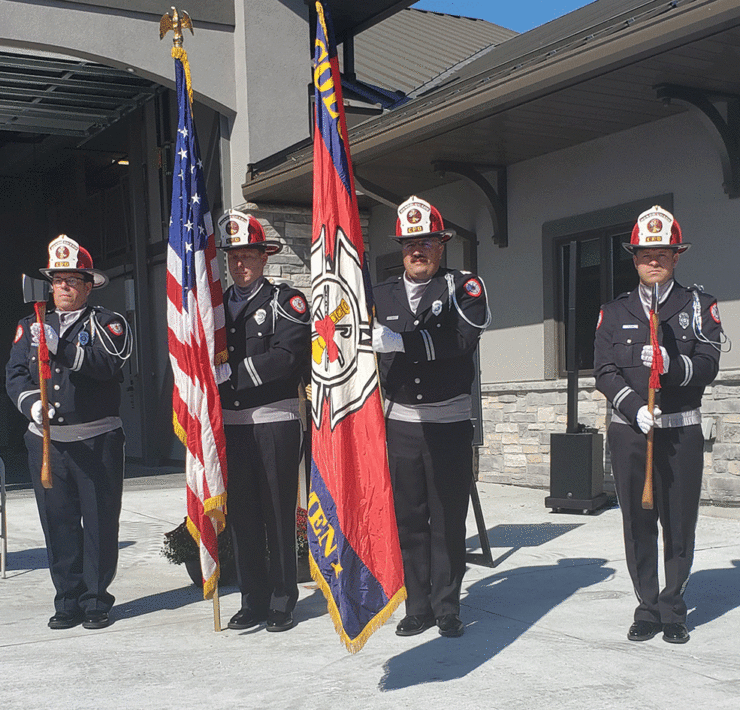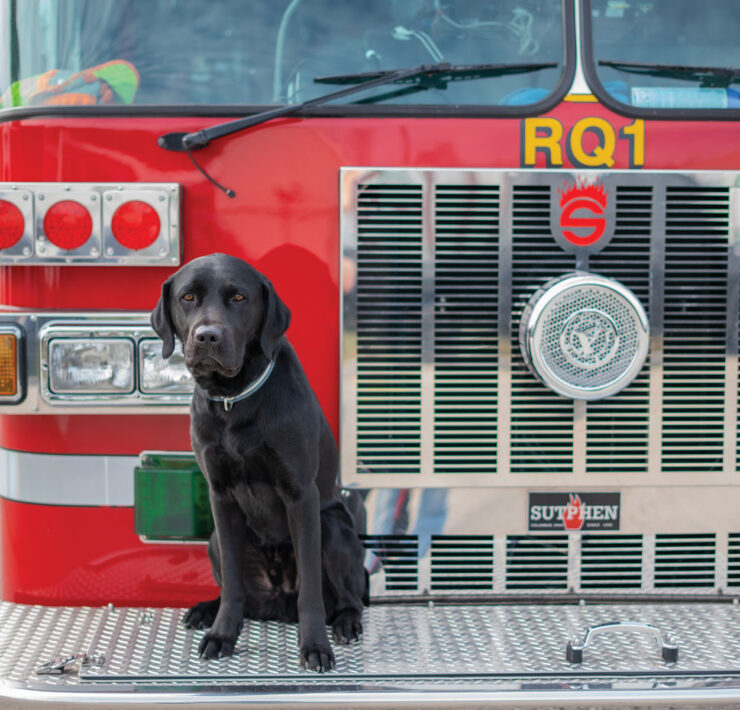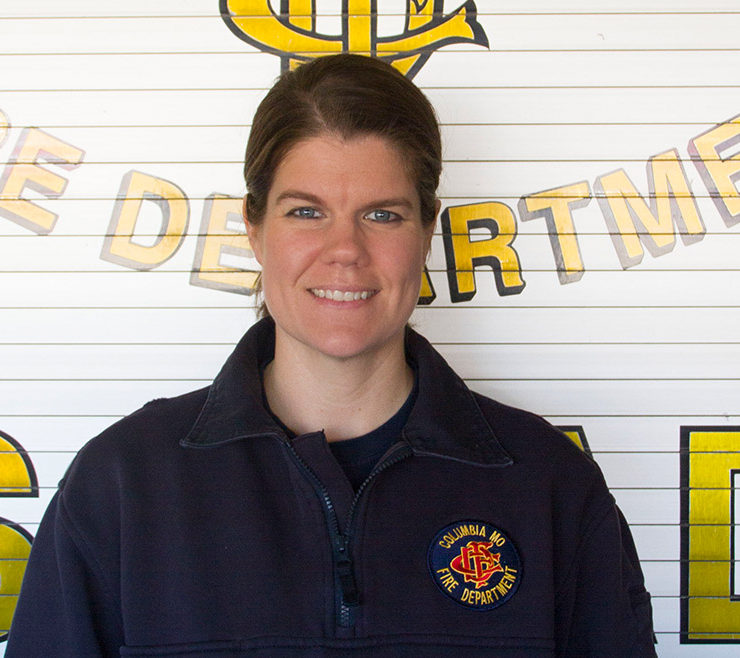The Columbia Fire Department is More than Fires
Columbia’s first snow of the year measured barely an inch, but it was enough to keep fire stations across the city busy all morning.
Plows were out, but roads were slick enough to cause eight car accidents before 9 a.m. on Dec. 18. Fire Station 1, Columbia’s busiest station, responded to half of the accidents, often with ambulance teams from University Hospital and Boone Hospital in tow. Several accidents required extrication, the specialized practice of removing trapped crash victims from their cars.
After rush hour, the six firefighters on duty at Fire Station 1 were ready for a slower afternoon. In their downtime, they have time to cook, chat and work out. But they’re always ready to respond; they try to be at the scene of an emergency in no more than five minutes.
Columbia firefighters working the 24-hour shift that covered most of Dec. 18 responded to 36 emergencies. That’s more than the 26 calls Battalion Chief Brad Fraizer says the department averages in a typical day. What was also above average was the number of fires the department responded to. In 24 hours, there were two fire calls — 5 percent of the day’s volume.
Behind the scenes
In the first 50 weeks of 2014, the Columbia Fire Department responded to 345 fire calls, which made up just 3 percent of the more than 11,000 incidents to which they were dispatched. Columbia’s firefighters may be most visible when they’re dousing flames, but in more than 60 percent of their calls, they respond to medical emergencies where their primary duty is to assist ambulance crews and provide basic medical care. It might seem like a strange division of labor for a department that is stretched thin as it struggles to expand its staff to meet the needs of a growing city, but as long as the Fire Department has nine stations and Columbia has just two ambulance hubs, the model of service is unlikely to change.
Even if ambulance personnel alone can handle a medical emergency, Fire Chief Randy White says a person’s life is more than worth what the Fire Department spends on gas each trip.
“We’re called the Fire Department, but we’re actually more like the emergency department,” White says. “Anything they don’t know who to send to, they send the Fire Department. That’s just part of what we do.”
White and Charles Witt, who retired as fire chief Jan. 31 after a 28-year career with the department, can recall dozens of unusual emergencies the department has responded to. Firefighters once rescued a parrot, and they’ve responded to a few real-life cases of cats in trees. They’ve gotten people out of stalled elevators and removed stuck pieces of jewelry. Compared to other departments of its size, the Columbia Fire Department’s duties, Fraizer says, are pretty typical.
In the case of medical emergencies, a fire truck and an ambulance are often dispatched to an emergency scene together to ensure quick response times and save the minutes wasted by calling backup later. Ambulances carry two emergency personnel, and it often takes more than two people to lift a stretcher into an ambulance. Fraizer says there are cases when a fire truck may head to a scene alone, but apart from scheduled medical transports, an ambulance would rarely go without a fire truck.
Columbia’s fire response system is standard, but the department, which has a $17.1 million budget for fiscal year 2015, a 9.5 percent increase from its estimated fiscal year 2014 budget of $15.6 million, hopes to hire more staff. It employs 137 firefighters but needs to hire 22 more to meet the National Fire Protection Association’s recommended staffing levels.
Proposition 1, a ballot initiative that would have raised property taxes to fund 15 new firefighting positions, failed in November. White, who took over for former Chief Charles Witt on Feb. 1, says the department is working on finding ways to hire new staff. In recent years, Witt secured more than $1 million in grant funding to hire five new firefighters and upgrade equipment, but the grant money is only temporary. The department training budget was cut when city finances shrunk, and White says one of his primary goals as the new chief is to find ways to add to that part of the budget. He says the department has a reputation to uphold.
“This department has been a leader, not only in this area but also in this state, of being able to be very good at what we do,” White says. “There are some great departments around the state, and we’re considered one of them.”
Fraizer says the department also has plans to construct a 10th fire station, which would take 12 firefighters to staff, to keep up with the increased number of calls that have come as Columbia’s population has grown. Medical call volume has increased at about 10 percent annually.
It takes a team
After the morning rush-hour accidents, Fire Station 1 had a slower afternoon. No fires. No car accidents. Just medical calls. For many calls that come in near downtown, Joint Communications, which handles 911 dispatch for Boone County, sends out Snozzle 1, one of the station’s two trucks, and an ambulance. Either service could arrive on a scene first.
Most fire trucks are dispatched with three fire station personnel. The most senior officer supervises the scene, while the other two tend to the emergency. On Snozzle 1’s first call of the afternoon — a woman in a medical clinic on Walnut Street was having trouble breathing — an ambulance from Boone Hospital Center beat it to the scene.
The truck driver noticed the ambulance’s flashing lights while maneuvering past a stopped car about a block from the clinic.
“I’d just about call that Christmas,” he says.
Inside the clinic, ambulance personnel were busy asking the woman questions about her medical history and checking her vital signs. The firefighters helped the ambulance crew load the woman onto a stretcher and into the ambulance. Fraizer says this sort of teamwork is common during a medical response.
“We work together very well with them,” Fraizer says of the ambulance staff. “Fire Department personnel stabilize and work to stop the forward progression of a medical event by providing basic life support and then transfer patient care over to ambulance personnel.”
Although all firefighters hold basic emergency medical technician training and some hold more advanced paramedic training, ambulance personnel have more medical equipment and can perform more services. In a medical emergency, firefighters try to stop the emergency from getting worse. They can control heavy bleeding, for example, or administer oxygen to a patient who is having difficulty breathing. They don’t, however, do more advanced skills such as administering medication or inserting IVs.
“Our goal is to stop the forward progress of a medical event,” Fraizer says. “Advanced medical support actually intervenes to reverse and better a medical event.”
On the next call, less than 20 minutes later, the Snozzle 1 team headed to Douglass High School, where a student had collapsed. This time, they arrived before the University Hospital ambulance. They grabbed their medical kit and an automated external defibrillator and were let in a side door. One firefighter began monitoring the boy’s heart rate and breathing and hooked him up to a portable oxygen machine. Another asked questions for a quick medical history. How old are you? Do you know where you are? Have you ever collapsed before? Does anything hurt?
When the ambulance arrived a few minutes later, the firefighters deferred the medical care to them. They went over the medical history they’d learned with the ambulance responders and took on a supporting role. One firefighter helped the boy sit up by having him lean against the firefighter’s leg. Another assembled a collapsible wheelchair for the boy and helped carry him down a short flight of stairs and load him in the ambulance. An ambulance worker handed one firefighter a new set of oxygen tubing to replace the one they used at the scene.
“Our people are problem-solvers,” White says. “The whole goal of our service is to get there, stop whatever is happening and then try to return it as close as possible to normal as we can.”
Like family
Afternoons at Station 1 tend to be slower, but calls usually pick up around rush hour. There usually aren’t many calls later in the evening, but the middle of the night can get busy, thanks to alcohol-fueled incident. A busy night can mean two hours of sleep, and getting anything close to seven uninterrupted hours is almost unheard of.
At Station 1, where everyone sleeps and lives in shared quarters, firefighters are quick to describe their co-workers like family. They bond over the course of 24-hour shifts and often make meals, work out or watch TV together between calls. Witt says firefighters have special bonds, but the camaraderie extends to the relationship the Fire Department has with ambulance staff and police officers as well.
“We’re all basically first responders, and we work hand in hand to deliver that public safety package,” Witt says.







